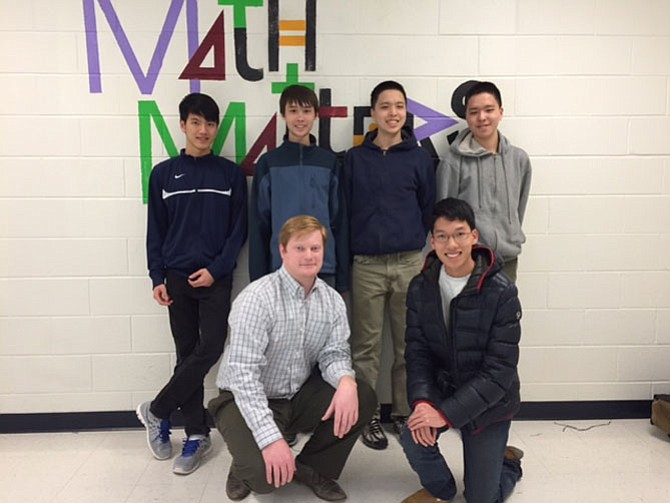The team of South County High School juniors (top, from left) Trung Nguyen, Alex Coppeans, James Wang, Peter Wang and (front right) Brian King, along with their teacher and team sponsor Daniel Southard will travel to New York City to compete in the applied math contest Moody’s Mega Math Challenge. Photo courtesy of Daniel Southard
It’s a question math students often ask their parents and teachers: When will I use this in real life? Last winter, South County High School math teacher Daniel Southard gave his students a concrete answer, attached to a financial incentive.
Southard advertised the Moody’s Mega Math Challenge, a national applied mathematics competition with $125,000 in scholarships available to winning teams, to his BC and Multi-variable Calculus students. Moody’s Foundation is an education-focused charitable organization founded by Moody’s Corporation, which deals in financial markets analysis and resources.
THE CHALLENGE is open to small teams of high school juniors and seniors: They’re given a complex social and or technological problem and limited time to solve it, using mathematics and outside research. Last year’s problem involved providing better-tasting school lunches; this year, students were asked to evaluate the cost of college education -- is it worth it?
“This is a prime example of a novel situation that involves a multitude of math concepts to come up with a unique solution,” Southard said. “You cannot look up how to solve this problem, there is no procedure that can be memorized.”
In December, Southard helped assemble an all-junior team comprising Trung Nguyen, Alex Coppeans, James Wang, Peter Wang and Brian King. The team met at King’s house on March 1 for the problem to be revealed electronically. They then had 14 hours to submit their solution.
Southard was restricted from even being present during the competition, so the students relied on online resources recommended by Moody’s, as well as published research to support their problem-solving. They weighed factors like tuition to two- versus four-year colleges, types of degrees against potential salaries in the job market and other elements that would influence an assessment of what college truly costs.
For Alex Coppeans, the research was an affirmation of “what I’ve been thinking about the past couple years, in general getting a Science Technology Engineering Math degree would be the best.”
Trung Nguyen said that through their research on various forms of college, “for certain fields, we found, it’s not worth it.” The team preferred to keep further details of their findings and computations under wraps.
About a month after the South County team submitted their 33-page solution report, Southard received an email that his students had been chosen as semifinalists in a group of 201 out of 1,128 that competed nationwide. A pair of teams from Thomas Jefferson High School for Science and Technology also made the first cut.
A week later, another email came saying South County had placed in the top six of the second round, meaning they would travel to New York City on April 27 to present their solution to a panel of judges and vie for bigger scholarship dollars.
“To be in top 200 is pretty awesome, I was fine with just that since it was the first time our school participated in this competition,” said Southard. But on receiving the email about finishing in the top six, he said, “That was just tenfold excitement on my part. It was such good news for our school and for the boys.”
BECOMING FINALISTS also meant surpassing the Jefferson teams, which did not continue as far in the competition. Many of the schools that regularly finish in the top 100, Southard said, are science and technology-focused, charter or private schools. “For us to be just a public, run of the mill school, feels really good,” Southard said. “And any time we can beat out TJ, it feels good.”
Southard is confident in the solution the students came up with and proud of the way they worked together on a tight deadline.
“The five of them are good friends and all very different in the ways they think,” he said. “To come together and put their minds together, that’s excellent. They were basically trying to solve the educational system’s problems in 14 hours and I think they did a really good job.”
In addition to the competition, Southard has arranged additional math-related stops for the students in New York, including the American Museum of Finance, the National Museum of Mathematics and the Hayden Planetarium.
